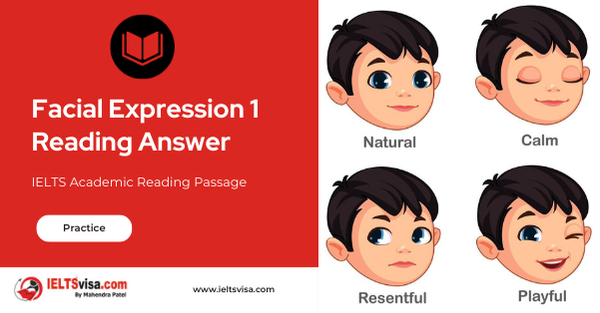Facial Expression 1 Reading Answer
IELTS Academic Reading Passage
A
A facial expression is one or more motions or positions of the muscles in the skin. These movements convey the emotional state of the individual to observers. Facial expressions are a form of nonverbal communication. They are a primary means of conveying social information among aliens, but also occur in most other mammals and some other animal species. Facial expressions and t.. heir significance in the perceiver can, to some extent, vary between cultures with evidence from descriptions in the works of Charles Darwin.
B
Humans can adopt a facial expression to read as a voluntary action. However, because expressions are closely tied to emotion, they are more often involuntary. It can be nearly impossible to avoid expressions for certain emotions, even when it would be strongly desirable to do so; a person who is trying to avoid insulting an individual he or she finds highly unattractive might, nevertheless, show a brief expression of disgust before being able to reassume a neutral expression. Microexpressions are one example of this phenomenon. The close link between emotion and expression can also work in the order direction; it has been observed that voluntarily assuming an expression can actually cause the associated emotion.
C
Some expressions can be accurately interpreted even between members of different species – anger and extreme contentment being the primary examples. Others, however, are difficult to interpret even in familiar individuals. For instance, disgust and fear can be tough to tell apart. Because faces have only a limited range of movement, expressions rely upon fairly minuscule differences in the proportion and relative position of facial features, and reading them requires considerable sensitivity to the same. Some faces are often falsely read as expressing some emotion, even when they are neutral because their proportions naturally resemble those another face would temporarily assume when emoting.
D
Also, a person’s eyes reveal much about hos they are feeling, or what they are thinking. Blink rate can reveal how nervous or at ease a person maybe. Research by Boston College professor Joe Tecce suggests that stress levels are revealed by blink rates. He supports his data with statistics on the relation between the blink rates of presidential candidates and their success in their races. Tecce claims that the faster blinker in the presidential debates has lost every election since 1980. Though Tecce’s data is interesting, it is important to recognize that non-verbal communication is multi-channelled, and focusing on only one aspect is reckless. Nervousness can also be measured by examining each candidates’ perspiration, eye contact and stiffness.
E
As Charles Darwin noted in his book The Expression of the Emotions in Man and Animals: the young and the old of widely different races, both with man and animals, express the same state of mind by the same movements. Still, up to the mid-20th century, most anthropologists believed that facial expressions were entirely learned and could, therefore, differ among cultures. Studies conducted in the 1960s by Paul Ekman eventually supported Darwin’s belief to a large degree.
F
Ekman’s work on facial expressions had its starting point in the work of psychologist Silvan Tomkins. Ekman showed that contrary to the belief of some anthropologists including Margaret Mead, facial expressions of emotion are not culturally determined, but universal across human cultures. The South Fore people of New Guinea were chosen as subjects for one such survey. The study consisted of 189 adults and 130 children from among a very isolated population, as well as twenty-three members of the culture who lived a less isolated lifestyle as a control group. Participants were told a story that described one particular emotion; they were then shown three pictures (two for children) of facial expressions and asked to match the picture which expressed the story’s emotion.
G
While the isolated South Fore people could identify emotions with the same accuracy as the non-isolated control group, problems associated with the study include the fact that both fear and surprise were constantly misidentified. The study concluded that certain facial expressions correspond to particular emotions and can not be covered, regardless of cultural background, and regardless of whether or not the culture has been isolated or exposed to the mainstream.
H
Expressions Ekman found to be universally included those indicating anger, disgust, fear, joy, sadness, and surprise (not that none of these emotions has a definitive social component, such as shame, pride, or schadenfreude). Findings on contempt (which is social) are less clear, though there is at least some preliminary evidence that this emotion and its expression are universally recognized. This may suggest that the facial expressions are largely related to the mind and each part on the face can express specific emotion.
Questions 1-5
Summary
Complete the Summary paragraph below. In boxes 1-5 on your answer sheet, write the correct answer with NO MORE THAN TWO WORDS
The result of Ekman’s study demonstrates that fear and surprise are
persistently 1………………… and made a conclusion that some facial expressions havesomething to do with certain 2……………………… Which is impossible covered, despite of 3………………… and whether the culture has been 4………………… or 5………………….. to the mainstream.
Questions 6-11
The reading Passage has seven paragraphs A-H
Which paragraph contains the following information?
Write the correct letter A-H, in boxes 6-11 on your answer sheet.
NB You may use any letter more than once.
6 the difficulty identifying the actual meaning of facial expressions
7 the importance of culture on facial expressions is initially described
8 collected data for the research on the relation between blink and the success in elections
9 the features on the sociality of several facial expressions
10 an indicator to reflect one’s extent of nervousness
11 the relation between emotion and facial expressions
Questions 12-13
Choose two letters from the A-E
Write your answers in boxes 12-13 on your answer sheet
Which Two of the following statements are true according to Ekman’s theory?
A No evidence shows animals have their own facial expressions.
B The potential relationship between facial expression and state of mind exists
C Facial expressions are concerning different cultures.
D Different areas on face convey a certain state of mind.
E Mind controls men’s facial expressions more obvious than women’s

Solution for: Facial Expression 1 Reading Answer
| 1. misidentified | 8. D |
| 2. emotions | 9. H |
| 3. cultural background | 10. D |
| 4. isolated | 11. B |
| 5. exposed | 12. B |
| 6. C | 13. D |
| 7. A |
Review and Practice
- Regularly practice with IELTS reading samples and time yourself to get used to the pressure of the exam.
- Review your mistakes to understand where you went wrong and how to avoid similar errors in the future.
Our Books
Master IELTS Speaking Part 1
IELTS Writing Task 1 Book
IELTS Writing Task 2 Book
Facial Expression 1 Reading Answer Explanation
Comin Soon
Practice IELTS Other Modules
IELTS Listening
The IELTS Listening test assesses how well you can understand spoken English in various contexts. It lasts about 30 minutes and is divided into four sections with a total of 40 questions. The listening tasks become increasingly difficult as the test progresses.
IELTS Academic Reading
The IELTS Academic Reading section assesses your ability to understand and interpret a variety of texts in academic settings. It is designed to evaluate a range of reading skills, including skimming for gist, reading for main ideas, reading for detail, understanding inferences, and recognizing a writer's opinions and arguments.
IELTS Speaking
The IELTS Speaking test assesses your ability to communicate in English on everyday topics. It lasts 11-14 minutes and consists of three parts: introduction, cue card, and a discussion based on the cue card topic.
IELTS General Reading
IELTS General Reading tests your ability to understand and interpret various types of texts. Here are some key areas and types of content you can expect to encounter in the reading section, along with tips for effective preparation.
IELTS Academic Writing Task 1
In IELTS Academic Writing Task 1, you are presented with a visual representation of information, such as graphs, charts, tables, or diagrams, and you are required to summarize, compare, or explain the data in your own words.
IELTS General Writing Task 1
In IELTS General Writing Task 1, you are required to write a letter based on a given situation. The letter can be formal, semi-formal, or informal, depending on the prompt. Here’s a breakdown of the key components to include in your letter
IELTS Academic Writing Task 2
In IELTS Academic Writing Task 2, you are required to write an essay in response to a question or topic. Here’s a guide to help you understand the essential elements of this task
IELTS Exam Tips
To succeed in the IELTS exam, practice regularly, familiarize yourself with the test format, improve your vocabulary, develop time management skills, and take mock tests to build confidence.
Grammer for IELTS
Grammar is the foundation of effective communication in English. Understanding tense usage, subject-verb agreement, and sentence structure enhances clarity and coherence in writing and speaking.
Vocabulary for IELTS
Vocabulary plays a crucial role in the IELTS (International English Language Testing System) exam, especially in the Speaking and Writing sections. Here’s an overview of why vocabulary is important and how it impacts your performance
RECENT IELTS SAMPLES QUESTIONS AND ANSWERS
The Life And work Of Marie Curie Reading Answer
Marie Curie is probably the most famous woman scientist who has ever lived. Born Maria...
Becoming An Expert Reading Answer
A Expertise is commitment coupled with creativity. Specifically, it is the commitment of...
STUDY CENTRE COURSES Reading Answer
SELF-STUDY TIPS AHowever difficult you find it to arrange your time, it will pay off in the...
The Extrinct Grass In Britain Reading Answer
A The British grass interrupted brome was said to be extinct, just like the Dodo. Called...
Morse Code Reading Answer
A. A new satellite-based system is being implemented to replace Morse code for sending...
Magnetic Therapy Reading Answer
AMagnetic therapy, which is a $5-billion market worldwide, is a form of alternative medicine...













